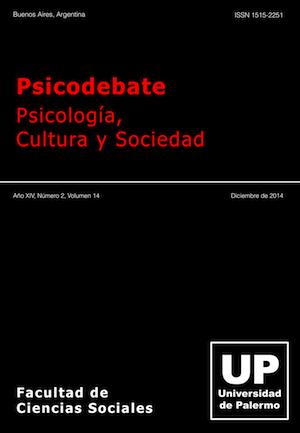El tratamiento a largo plazo del trastorno bipolar
Resumen
Las indicaciones medicamentosas para el tratamiento del trastorno bipolar (TB) requieren de una ponderación de la necesidad de tratamiento del episodio en curso y su evolución a largo plazo. Los objetivos principales radicarán en estabilizar el ánimo, evitar un episodio de polaridad opuesta y prevenir posibles recaídas. Dentro del abanico de tratamientos disponibles se encuentran los estabilizadores del humor, los antipsicóticos, los antidepresivos, y las terapias no farmacológicas. En el presente trabajo se realiza un recorrido sobre las ventajas y desventajas de estos tratamientos. La evidencia empírica indica que el litio resulta el estabilizador del humor más utilizado siendo considerado como gold standard para la prueba de nuevos tratamientos. Los antipsicóticos suelen ser los fármacos de elección para episodios maníacos con o sin este tipo de síntomas y prefiriéndose a los atípicos por presentar menores efectos secundarios. El uso de antidepresivos debe ser cauteloso por el riesgo de polarización a estados maníacos. Finalmente, dentro de las terapias no farmacológicas, la terapia cognitivo conductual y la psicoeducación son consideradas las intervenciones más eficaces.
Descargas
Citas
Akiskal, H. S., Cassano, G. B., Musetti, L., Perugi, G., Tundo, A., &, Mignani, V. (1989). Psychopathology, temperament, and past course in primay major depression. 1. Review of evidence for a bipolar spectrum. Psychopathology, 22, 268–277.
Baldessarini, R. J., Bolzani, L., Cruz, N., Jones, P. B., Lai, M., Lepri, B., … Vieta, E. (2010). Onset–age of bipolar disorders at six international sites. Journal of Affective Disorders, 121, 143–146.
Baldessarini, R. J., Tondo, L., Davis, P., Pompili, M., Goodwin, F. K., & Hennen, J. (2006). Decreased risk of suicides and attempts during long–term lithium treatment: a meta–analytic review. Bipolar Disorders, 8, 625–639.
Faedda, G. L., Baldessarini, R. J., Tohen, M., Strakowski, S. M., & Waternaux, C. (1991). Episode sequence in bipolar disorder and response to lithium treatment. The American Journal of Psychiatry, 148, 1237–1239.
Fountoulakis, K. N. & Vieta, E. (2008). Treatment of bipolar disorder: a systematic review of available data and clinical perspectives. The International Journal of Neuropsychopharmacology, 11, 999–1029.
Gitlin, M. J., Cochran, S. D., & Jamison, K. R. (1989). Maintenance lithium treatment: side effects and compliance. Journal of Clinical Psychiatry, 50, 127–131.
Goodwin, F. K. & Jamison, K. R. (2007). Manic–Depressive Illness. New York, NY: Oxford University Press.
Grof, E., Haag, M., Grof, P., & Haag, H. (1987). Lithium response and the sequence of episode polarities: preliminary report on a Hamilton sample. Progress in Neuro–Psychopharmacology & Biological Psychiatry, 11, 199–203.
Grunze, H., Vieta, E., Goodwin, G. M., Bowden, C., Licht, R. W., Moller, H. J., & Kasper, S. (2009). The World Federation of Societies of Biological Psychiatry (WFSBP) guidelines for the biological treatment of bipolar disorders: update 2009 on the treatment of acute mania. The World Journal of Biological Psychiatry, 10, 85–116.
Haag, H., Heidorn, A., Haag, M., & Greil, W. (1987). Sequence of affective polarity and lithium response: preliminary report on Munich sample. Progress in Neuro–Psychopharmacology & Biological Psychiatry, 11, 205–208.
Kaplan, B. J., Sadock, V. A., & Ruiz, P. (2009). Kaplan & Sadock's comprehensive textbook of psychiatry (9na ed.). Philadelphia, PA: Lippincott Williams & Wilkins.
Klerman, G. L. (1981). The spectrum of mania. Comprehensive Psychiatry, 22, 11–20.
Kukopulos, A., Reginaldi, D., Laddomada, P., Floris, G., Serra, G., & Tondo, L. (1980). Course of the manic–depressive cycle and changes caused by treatment. Pharmakopsychiatr Neuropsychopharmakol, 13, 156–167.
Maj, M., Pirozzi, R., & Starace, F. (1989). Previous pattern of course of the illness as a predictor of response to lithium prophylaxis in bipolar patients. Journal of Affective Disorders, 17, 237–241.
Merikangas, K. R., Akiskal, H. S., Angst, J., Greenberg, P. E., Hirschfeld, R. M. A., Petukhova, M., & Kessler, R.C. (2007). Lifetime and 12–Month Prevalence of Bipolar Spectrum Disorder in the National Comorbidity Survey Replication. Archives of General Psychiatry, 64, 543–552.
Schatzberg, A., & Nemeroff, C. (2009). Textbook of Psychopharmacology (4ta ed.). Washington, DC: The American Psychiatric Publishing.
Thase, M. E., Macfadden, W., Weisler, R. H., Chang, W., Paulsson, B., Khan, A., BOLDER II Study Group. (2006). Efficacy of quetiapine monotherapy in bipolar I and II depression: a double–blind, placebo–controlled study (the BOLDER II study). Journal of Clinical Psychopharmacology, 26(6), 600–609.
Tondo, L., Hennen, J., & Baldessarini, R. J. (2001). Lower suicide risk with long–term lithium treatment in major affective illness: A meta–analysis. Acta Psychiatrica Scandinavica, 104, 163–172.
Tondo, L., Lepri, B., Cruz, N., & Baldessarini, R. J. (2010). Age at onset in 3014 Sardinian bipolar and major depressive disorder patients. Acta Psychiatrica Scandinavica, 121, 446–452.
Tondo, L., Vázquez, G., & Baldessarini, R. J. (2010). Mania and hypomania associated with antidepressant treatment: comprehensive meta–analytic review. Acta Psychiatrica Scandinavica, 121, 404–414.
Turvey, C. L., Coryell, W. H., Arndt, S., Solomon, D. A., Leon, A. C., Endicott J, … Akiskal, H. (1999). Polarity sequence, depression, and chronicity in bipolar I disorder. The Journal of Nervous and Mental Disease, 187, 181–187.
Los autores/as que publiquen en esta revista ceden los derechos de autor y de publicación a Psicodebate y aceptan el registro de su trabajo bajo una licencia de atribución de Creative Commons, que permite a terceros utilizar lo publicado siempre que de el crédito pertinente a los autores y a Psicodebate

















